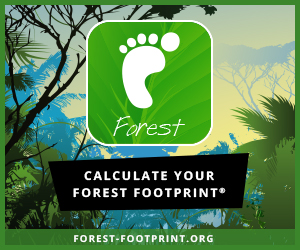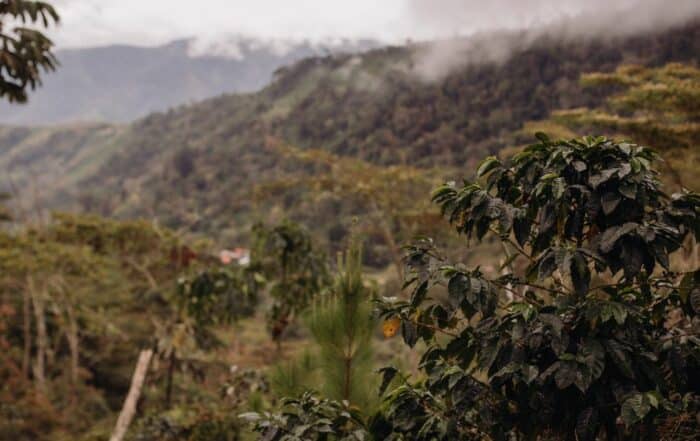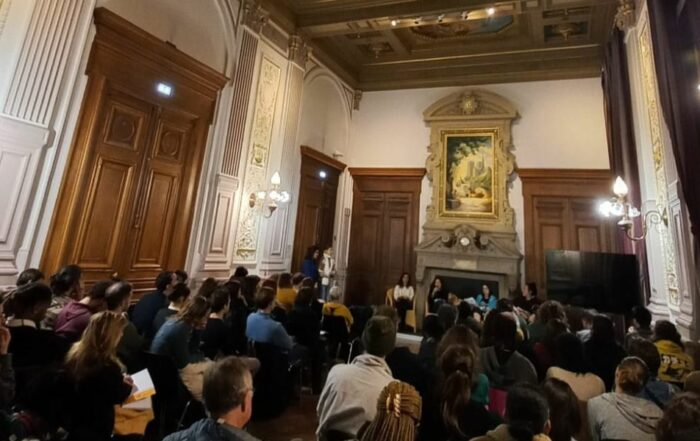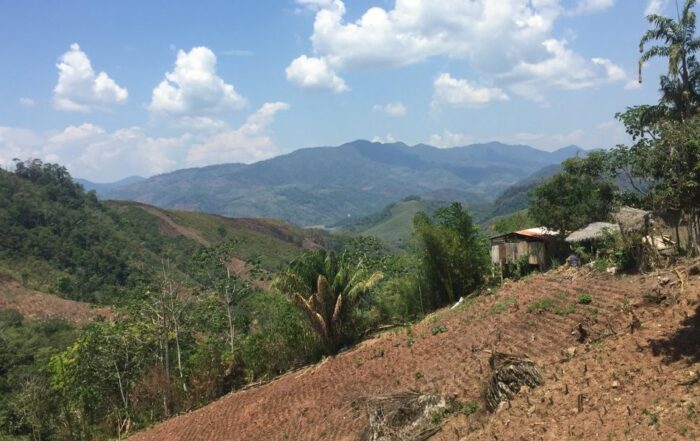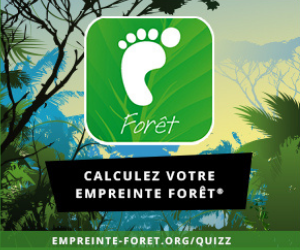Since the launch of Envol Vert’s Forest Footprint quiz, the association has been pleasantly surprised by the very marked interest among French people in understanding the link between deforestation, commodities and their consumption of everyday goods. It’s an excellent sign – as long as businesses and the authorities follow suit and start to offer deforestation-free goods.
When the quiz was launched in late 2014, we were hoping that 10,000 people would measure their Forest Footprint, but in fact a total of 40,000 had taken the quiz by the end of last year!
Calculate your Forest Footprint
Envol Vert thus called on two doctors, Nadine Lambert and Benjamin Geffroy, to analyse the results so we could learn a bit more about the people who measure their forest footprint.
Given the number of participants, the results are highly significant. The figures below concern the 26,934 people who took the test during the first three months after its launch.
Consumers are aware… but not enough
The Forest Footprint is measured on the basis of:
– The quantity of goods consumed and that directly (such as palm oil) or indirectly (via soy in animal feed) contain ingredients and/or components associated with deforestation, such as eggs (Question 5), poultry (Question 6), dairy products (Question 7), pork (Question 8), fresh foods (Question 9), and tea and coffee (Question 13).
– Lifestyle and its impact on the forests through the consumption of non-food items: (shoe leather (Question 1), leather items and accessories (Question 2), paper (Question 3), exotic wood items (Question 4), cosmetic and hygiene products (Question 10).
These questions concern the quantities of products consumed and vary based on the average quantity of products consumed by the French population. Finally, the issue of sustainability is addressed with additional questions on certified, reused and local goods and on more sustainable lifestyles.
The main finding about the people having measured their Forest Footprint is that they consume less than the French average of the main goods associated with deforestation.
If we take the example of pork, which may be fed with soy from South America, they consume it once or twice a week. As far as exotic wood is concerned, they say they own less than 1 item per person in their home.
However, while they consume fewer items known to be associated with deforestation than the national average, in other categories, less clearly linked to deforestation, their consumption is on a par with the French norm, with more than 2 eggs a week, 1 to 2 dairy products per day and between 1 and 2 cups of tea or coffee.
It is clear that, for certain products such as exotic woods and meat, their links with deforestation and their environmental impact are well-known and these items are consumed less overall. However, products with a more indirect link, such as dairy products, which come from cows fed on soy (the most imported commodity in France), are given less media coverage and are less clearly associated with deforestation by the French and for those goods, consumption is comparable to the national average.
This proves the awareness-raising has an effect but for the products with the most indirect links, the authorities need to take action and provide people with clearer information about the food on their plates.
While sustainable consumption figures for the French appear quite low, there is some good news for the third of product categories where the French consume more forest-friendly goods (certified responsible goods, locally produced or recycled goods, etc.). However, given that the people taking the quiz already appear to be aware of environmental issues, we could be led to believe that consumer habits are not shifting towards more responsible goods among the rest of the population
A much bigger Forest Footprint in southwestern France
France was divided into five main regions on the basis of latitudinal and longitudinal data: the northeast (NE), northwest (NW), southeast (SE), southwest (SW) and the Paris region.
The Paris region recorded the highest number of respondents at 43%.
In the four other regions, the number of respondents varied from 12-16% of the total. Given that the Paris region accounts for 18% of the total French population, we can say that twice as many of its inhabitants have calculated their forest footprint.
There are some major differences in the regions’ results, and between two regions in particular. Southeast France has the lowest Forest Footprint with much lower animal protein consumption; likewise tropical wood and electronic devices, and there is also a tendency to avoid processed goods containing palm oil. This responsible behaviour also applies to the consumption of more forest-friendly goods among the population in the southeast (16% of those who responded).
In the southwest, on the other hand, consumption of meat products, which involve soy from Latin America, is much higher. In addition, its inhabitants are also France’s biggest car users and consume more exotic wood, hygiene products potentially containing palm oil derivatives, and tea, meaning this part of the country has the worst overall Forest Footprint in France. Since these analyses were done using a very large database, the results are significant!
Finally, the southwest also scores low because, as well as having a high Forest Footprint, the region’s inhabitants are the least likely to commit to the actions suggested at the end of Envol Vert’s quiz and sign up to the forest pact (replacing animal proteins by plant sources, replacing chocolate spread with honey, recycling all their paper, etc.).
Le Sud-ouest par contre consomme plus de produits carnés qui nécessitent du soja d’Amérique latine. Mais ses habitants s’avèrent aussi être de plus grands usagers de la voiture, de bois tropicaux, de produits d’hygiène pouvant contenir des dérivés d’huile de palme et aussi de thé ce qui en fait la région mauvaise élève de la France avec et de la loin la plus forte Empreinte Forêt. Ces analyses étant réalisées avec de très grande base de données donnent des résultats significatifs !
Enfin, le comble pour le Sud-Ouest est qu’en plus qu’ils aient une forte Empreinte ce sont aussi ceux qui s’engagent le moins pour les bonnes actions proposées à la fin du Quiz par Envol Vert avec la l’engagement à signer le pacte forêt (remplacer les protéines animales par des végétales, remplacer la pâte à tartiner par du miel, recycler tous ses papiers, etc.).
These results show that forest-friendly consumer habits are developing but that they are not yet widespread across France or applied to all goods.
Given the impact of deforestation, the French people’s interest in these issues and the role of Europe in the trade of commodities associated with deforestation, Envol Vert is asking for urgent action to stop the import of commodities that do not provide any guarantee, and for clearer information to be indicated on consumer goods.
“In 2015, the fires in Indonesia and greater awareness about the Forest Footprint among French people served as a reminder to states and businesses of their responsibilities and the urgent need to introduce robust and effective “zero deforestation” policies,” insists Daisy Tarrier, Envol Vert’s president.”
Since the launch of Envol Vert’s Forest Footprint quiz, the association has been pleasantly surprised by the very marked interest among French people in understanding the link between deforestation, commodities and their consumption of everyday goods. It’s an excellent sign – as long as businesses and the authorities follow suit and start to offer deforestation-free goods.
When the quiz was launched in late 2014, we were hoping that 10,000 people would measure their Forest Footprint, but in fact a total of 40,000 had taken the quiz by the end of last year!
Calculate your Forest Footprint
Envol Vert thus called on two doctors, Nadine Lambert and Benjamin Geffroy, to analyse the results so we could learn a bit more about the people who measure their forest footprint.
Given the number of participants, the results are highly significant. The figures below concern the 26,934 people who took the test during the first three months after its launch.
Consumers are aware… but not enough
The Forest Footprint is measured on the basis of:
– The quantity of goods consumed and that directly (such as palm oil) or indirectly (via soy in animal feed) contain ingredients and/or components associated with deforestation, such as eggs (Question 5), poultry (Question 6), dairy products (Question 7), pork (Question 8), fresh foods (Question 9), and tea and coffee (Question 13).
– Lifestyle and its impact on the forests through the consumption of non-food items: (shoe leather (Question 1), leather items and accessories (Question 2), paper (Question 3), exotic wood items (Question 4), cosmetic and hygiene products (Question 10).
These questions concern the quantities of products consumed and vary based on the average quantity of products consumed by the French population. Finally, the issue of sustainability is addressed with additional questions on certified, reused and local goods and on more sustainable lifestyles.
The main finding about the people having measured their Forest Footprint is that they consume less than the French average of the main goods associated with deforestation.
If we take the example of pork, which may be fed with soy from South America, they consume it once or twice a week. As far as exotic wood is concerned, they say they own less than 1 item per person in their home.
However, while they consume fewer items known to be associated with deforestation than the national average, in other categories, less clearly linked to deforestation, their consumption is on a par with the French norm, with more than 2 eggs a week, 1 to 2 dairy products per day and between 1 and 2 cups of tea or coffee.
It is clear that, for certain products such as exotic woods and meat, their links with deforestation and their environmental impact are well-known and these items are consumed less overall. However, products with a more indirect link, such as dairy products, which come from cows fed on soy (the most imported commodity in France), are given less media coverage and are less clearly associated with deforestation by the French and for those goods, consumption is comparable to the national average.
This proves the awareness-raising has an effect but for the products with the most indirect links, the authorities need to take action and provide people with clearer information about the food on their plates.
While sustainable consumption figures for the French appear quite low, there is some good news for the third of product categories where the French consume more forest-friendly goods (certified responsible goods, locally produced or recycled goods, etc.). However, given that the people taking the quiz already appear to be aware of environmental issues, we could be led to believe that consumer habits are not shifting towards more responsible goods among the rest of the population
A much bigger Forest Footprint in southwestern France
France was divided into five main regions on the basis of latitudinal and longitudinal data: the northeast (NE), northwest (NW), southeast (SE), southwest (SW) and the Paris region.
The Paris region recorded the highest number of respondents at 43%.
In the four other regions, the number of respondents varied from 12-16% of the total. Given that the Paris region accounts for 18% of the total French population, we can say that twice as many of its inhabitants have calculated their forest footprint.
There are some major differences in the regions’ results, and between two regions in particular. Southeast France has the lowest Forest Footprint with much lower animal protein consumption; likewise tropical wood and electronic devices, and there is also a tendency to avoid processed goods containing palm oil. This responsible behaviour also applies to the consumption of more forest-friendly goods among the population in the southeast (16% of those who responded).
In the southwest, on the other hand, consumption of meat products, which involve soy from Latin America, is much higher. In addition, its inhabitants are also France’s biggest car users and consume more exotic wood, hygiene products potentially containing palm oil derivatives, and tea, meaning this part of the country has the worst overall Forest Footprint in France. Since these analyses were done using a very large database, the results are significant!
Finally, the southwest also scores low because, as well as having a high Forest Footprint, the region’s inhabitants are the least likely to commit to the actions suggested at the end of Envol Vert’s quiz and sign up to the forest pact (replacing animal proteins by plant sources, replacing chocolate spread with honey, recycling all their paper, etc.).
Le Sud-ouest par contre consomme plus de produits carnés qui nécessitent du soja d’Amérique latine. Mais ses habitants s’avèrent aussi être de plus grands usagers de la voiture, de bois tropicaux, de produits d’hygiène pouvant contenir des dérivés d’huile de palme et aussi de thé ce qui en fait la région mauvaise élève de la France avec et de la loin la plus forte Empreinte Forêt. Ces analyses étant réalisées avec de très grande base de données donnent des résultats significatifs !
Enfin, le comble pour le Sud-Ouest est qu’en plus qu’ils aient une forte Empreinte ce sont aussi ceux qui s’engagent le moins pour les bonnes actions proposées à la fin du Quiz par Envol Vert avec la l’engagement à signer le pacte forêt (remplacer les protéines animales par des végétales, remplacer la pâte à tartiner par du miel, recycler tous ses papiers, etc.).
These results show that forest-friendly consumer habits are developing but that they are not yet widespread across France or applied to all goods.
Given the impact of deforestation, the French people’s interest in these issues and the role of Europe in the trade of commodities associated with deforestation, Envol Vert is asking for urgent action to stop the import of commodities that do not provide any guarantee, and for clearer information to be indicated on consumer goods.
“In 2015, the fires in Indonesia and greater awareness about the Forest Footprint among French people served as a reminder to states and businesses of their responsibilities and the urgent need to introduce robust and effective “zero deforestation” policies,” insists Daisy Tarrier, Envol Vert’s president.”

